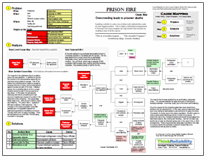By Kim Smiley
Within a week, three separate incidents occurred at the San Onofre Nuclear Generating Station, located near heavily populated areas, raising new concerns about the safety of the nuclear power plant.
This issue can be investigated by building a Cause Map, an intuitive, visual root cause analysis. The first step in building a Cause Map is to determine what goals are impacted by the issue being considered. In this case, the main goal being considered is safety. If the Cause Map was being built from the perspective of the power plant company, then the production and schedule impacts would also need to be considered, but in this example we will focus on the safety impacts.
The safety goal is impacted because some people are concerned about the safety of the power plant because it is near heavily populated areas and three separate incidents occurred within days of each other. The three incidents in question were the release of a small amount of radiation, discovery of unexpected amounts of wear on steam generator tubes, and the potential contamination of a worker.
 A small amount of radiation was released because a steam generator tube, which carries radioactive water, was leaking. Luckily, the leak was small and the plant was quickly shut down after the leak was discovered so no significant amounts of radiation were released. A second reactor unit is currently shut down for maintenance and inspection of the steam generator tubes found significantly more wear than expected on some of the tubes. The wear was unexpected because the tubes have only been in service for 22 months and two tubes had 30% wall thinning, 69 tubes had 20% wall thinning and 800 had 10% wall thinning. The situation is being investigated, but neither the cause of the wear nor the best course of action has not yet been determined. The final incident was the potential contamination of a worker because he fell into a reactor pool. According to media reports, the worker was trying to retrieve a flash light and lost his footing.
A small amount of radiation was released because a steam generator tube, which carries radioactive water, was leaking. Luckily, the leak was small and the plant was quickly shut down after the leak was discovered so no significant amounts of radiation were released. A second reactor unit is currently shut down for maintenance and inspection of the steam generator tubes found significantly more wear than expected on some of the tubes. The wear was unexpected because the tubes have only been in service for 22 months and two tubes had 30% wall thinning, 69 tubes had 20% wall thinning and 800 had 10% wall thinning. The situation is being investigated, but neither the cause of the wear nor the best course of action has not yet been determined. The final incident was the potential contamination of a worker because he fell into a reactor pool. According to media reports, the worker was trying to retrieve a flash light and lost his footing.
To view a high level Cause Map of this incident, click “Download PDF” above. The Cause Map can be expanded as more information comes available so that it can document and illustrate as much detail as needed to evaluate the issues.
As it stands, both the reactor units with the steam generator tubes are shut down. The unit that experienced the leak is shutdown pending investigation and any necessary repairs. The second unit that had the unexpected wall thinning in the steam generator tubes is in a planned shutdown of several months while it is refueled and upgraded. The plants will be brought back online once it’s determined safe to do so.









